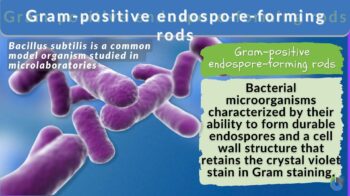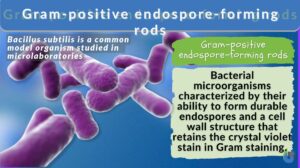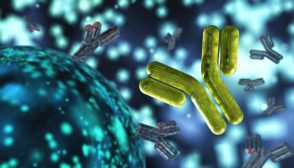
Gram-positive endospore-forming rods
n., singulargram-positive endospore-forming rod
[ɡræm ˈpɑzətɪv ˈɛndəˌspɔr ˈfɔrmɪŋ rɒdz]
Definition: Resilient bacterial organisms with enduring endospores and a distinct cell wall structure
Table of Contents
Gram-Positive Endospore-Forming Rods Definition
Gram-positive endospore-forming rods are a group of rod-shaped bacteria that are positive for Gram’s staining, and form endospores. As regards Gram’s method, these bacteria are those whose cells appear as violet rods under the microscope in contrast to those bacteria that appear violet too but spherical (referred to as Gram-positive cocci), as well as to those that are rods but render a pinkish color (referred to as Gram-negative rods).
Overview of the Gram Staining Method
The gram staining method was developed by Danish bacteriologist Hans Christian Gram in the 1880s. The technique involves fixing bacterial samples in glass slides and then treating them with a series of dyes, firstly, with Crystal Violet (a purple-colored dye), next with an iodine solution to affix the initial stain, then with Safranin ( a red or pink dye). This technique is a common method in classifying bacteria into two major groups:
- Gram-positive bacteria: cells appear violet or bluish in color
- Gram-negative bacteria: cells appear pink in color
GRAM POSITIVE VS GRAM NEGATIVE BACTERIA (by Neural Academy):
Gram-positive bacteria appear violet (or bluish) under the microscope when treated with Gram staining because the crystal violet dye fixed with the iodine mordant is retained in their outer covering.
Gram-positive bacteria do not appear pink because they did not take the safranin counterstain as gram-negative bacteria would. The main reason is the thick cell wall that Gram-positive bacteria have. Their cell wall has a thick layer of peptidoglycan chains that are cross-linked by the enzyme DD-transpeptidase. The rigid cell wall becomes dehydrated when treated with a decolorizing agent during gram staining. This prevents the efflux of the initial stain. Thus, Gram-positive bacteria remain violet even when a counterstain is introduced.
Further classification of Gram-positive bacteria
Gram-positive bacteria may be classified based on shape, such as into Gram-positive cocci (spherical) or Gram-positive bacilli (rod-shaped). Gram-positive bacilli can be classified into endospore formers and not. Endospores are structures indicating a dormant stage in certain bacteria.
Biology definition:
Gram-positive endospore-forming rods are a group of rod-shaped bacteria that are positive to Gram’s method and form endospores. These bacteria would already take the initial stain (Crystal Violet) and thus would render violet or bluish in color under the microscope due to their thick cell wall. Gram-positive endospore-forming bacilli include Bacillus spp. and Clostridium spp.
Etymology: The term “Gram-positive” refers to the bacteria’s ability to retain the crystal violet stain in the Gram stain test, while “endospore-forming rods” describes their rod-shaped morphology and capability to produce endospores.
Synonym: gram-positive endospore-forming bacilli
Characteristics
- Gram-positive endospore-forming rods have a thick peptidoglycan cell wall.
- They are rod-shaped.
- They form endospores when under stress.
Endospore Formation
Endospores are highly resistant structures formed when the cell is exposed to unfavorable conditions. Endospore formation is a survival strategy of many bacteria to endure until the conditions become favorable again. Examples of unfavorable conditions are heat, desiccation (extreme dryness), radiation, certain chemicals, and extreme pH levels. Some endospores are able to survive sterilization, such as autoclaving. Thus, some sterilization techniques involve increasing or prolonging exposure times.
The endospores are specialized structures with thick walls. They are smaller compared with their cells in the vegetative (actively growing, reproducing) state.
Inside a typical endospore are the genetic material and essential enzymes. Surrounding this core is the cortex, which, in turn, is surrounded by a proteinaceous spore coat and, in some cases, an exosporium.
The process of forming spores is called sporulation. When they return to their vegetative state, the process is referred to as germination.
NOTE IT!
Question: Is spore formation exclusive to bacteria?
No! Many other organisms produce spores as well. While many bacillus species can form spores, there are other organisms that produce spores as well. Examples of such organisms are plants, certain fungi (e.g., Zygomycota), and protists/algae (e.g., dinoflagellates, zooxanthellae, and some green algae). However, their spores are notably different from bacterial endospores in many aspects. While the spores produced by spore-forming organisms contain genetic material their spores differ in structure and primary purpose.
- Bacterial endospores have a core surrounded by protective layers. Spores of eukaryotic cells are rather more complex, with special structures for attachment or mechanisms for dispersal or dormancy.
- While bacterial endospores are efficient at protecting the bacterial cell from adverse conditions, the spores produced by other organisms are not as resilient as the bacterial endospores.
- Thus, the primary purpose of bacterial endospores is for bacterial survival under extreme environmental conditions. The spores of other organisms are primarily for reproduction and dispersal and shall develop into new individuals when conditions are suitable.
Examples Of Gram-Positive Endospore-Forming Rods
Gram-positive endospore-forming rods are a group of bacteria belonging to the phylum Firmicutes, particularly the genus Bacillus and genus Clostridium. However, not all are capable of producing endospores (e.g., Corynebacterium sp., Listeria sp., Actinomyces sp., Corynebacterium sp.).
Many Bacillus species and Clostridium species are Gram-positive endospore-forming bacterial rods. Specific examples include the following:
- Bacillus anthracis, the causative agent of anthrax
- Bacillus cereus, a common foodborne pathogen
- Bacillus subtilis, a model organism for studying sporulation
- Clostridium tetani, associated with tetanus
- Clostridium botulinum, associated with botulism
- Clostridium perfringens, associated with food poisoning and gas gangrene
Importance
Gram-positive endospore-forming rods are important in the ecosystems where they participate in nutrient cycling and decomposition processes. They break down organic matter in soil and other environments, aiding in the recycling of nutrients. They can also influence microbial communities through competition and niche specialization.
In biotechnology, they are used for the production of enzymes (e.g., amylases and proteases), antibiotics, and other valuable bioproducts.
NOTE IT!
Botox! Yes, it’s the toxin produced by Gram-positive endospore-forming rod species, Clostridium botulinum
In medicine, the botulinum toxin produced by Clostridium botulinum is one of the deadliest toxins known. It is widely used for therapeutic and cosmetic purposes. Botulinum toxin (BoNT) is a neurotoxin categorized from A through G. The toxin works by blocking the release of acetylcholine, interfering with the transmission of signals between neurons and myocytes. Its muscle paralytic effect is used to treat conditions such as spasms and excessive muscle contractions.
Botox, a botulinum toxin type A, works by temporarily paralyzing facial muscles, thereby reducing the appearance of wrinkles resulting in smoother skin.

Further Reading
References
- Setlow, P. (n.d.). The bacterial spore: nature’s survival package. Retrieved September 17, 2023, from http://www.oxoid.com/culture/26-2.pdf
- Madigan M; Martinko J (editors). (2005). Brock Biology of Microorganisms (11th ed.). Prentice Hall.
- Prescott’s Microbiology, 11th Edition (2016).
- Madigan, M.T., Martinko, J.M., & Bender, K.S. (2018). Brock Biology of Microorganisms, 15th Edition.
- Stülke, J., & Ricca, E. (Eds.). (2020). Bacterial Spores: From Molecules to Systems. Springer.
- Paredes-Sabja, D., Setlow, P., & Sarker, M.R. (2011). Germination of Spores of Bacillales and Clostridiales Species: Mechanisms and Proteins Involved. Trends in Microbiology, 19(2), 85-94.
©BiologyOnline.com. Content provided and moderated by Biology Online Editors.







